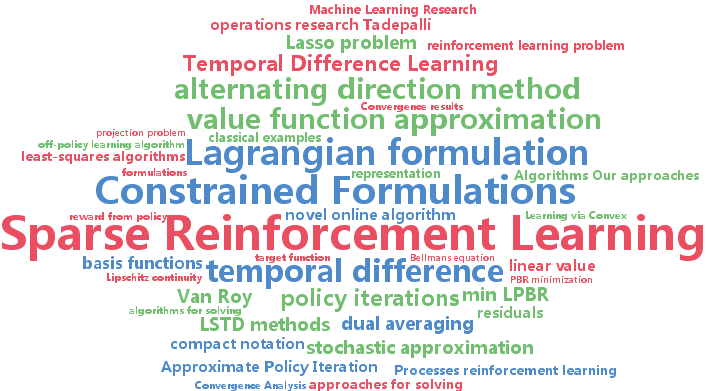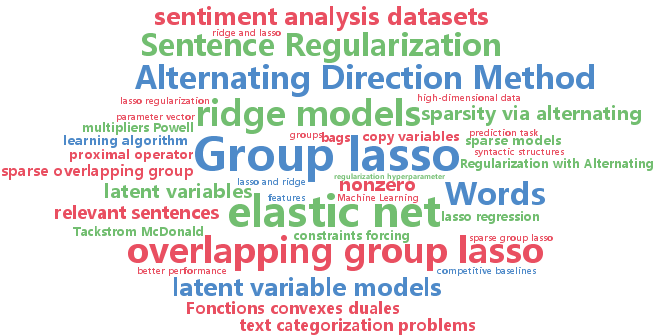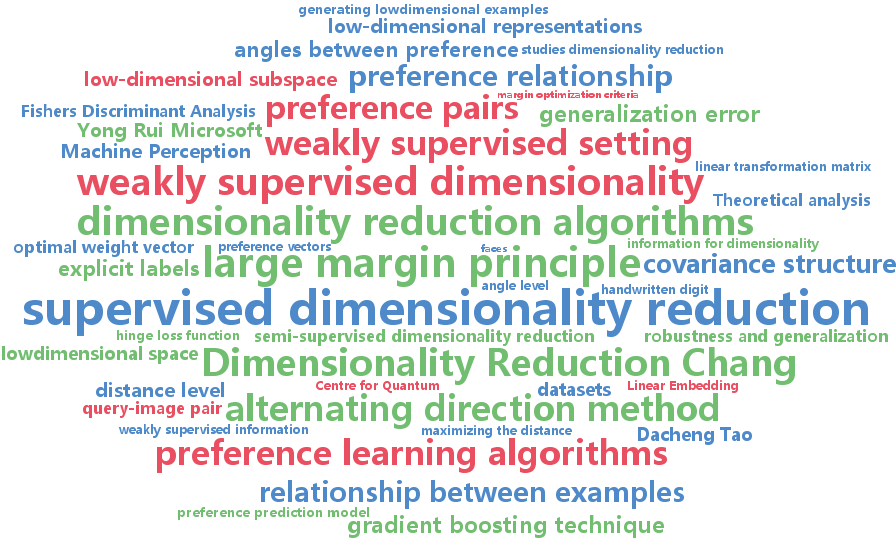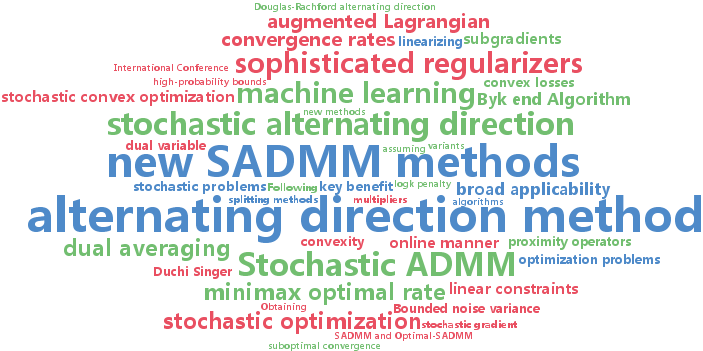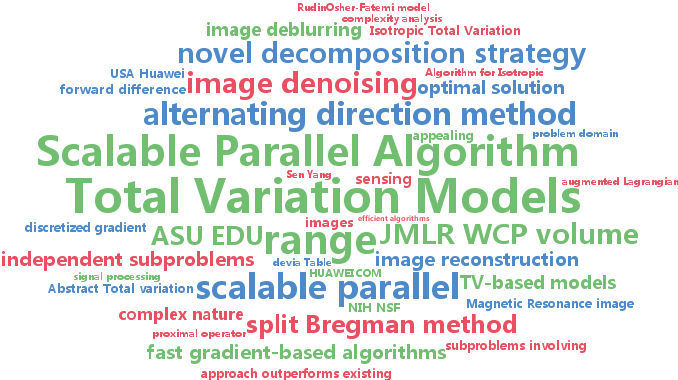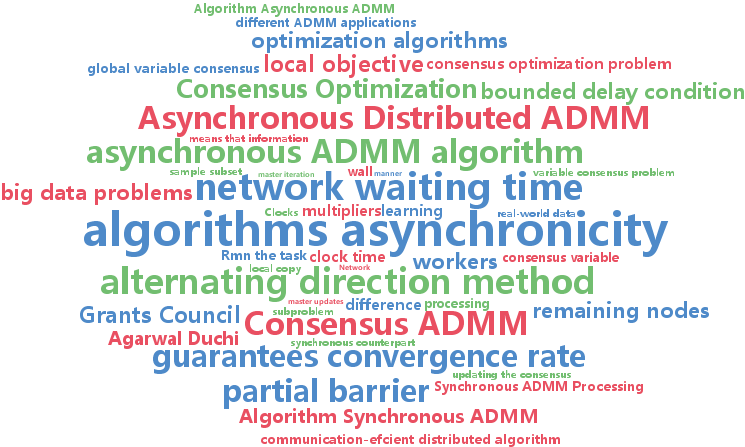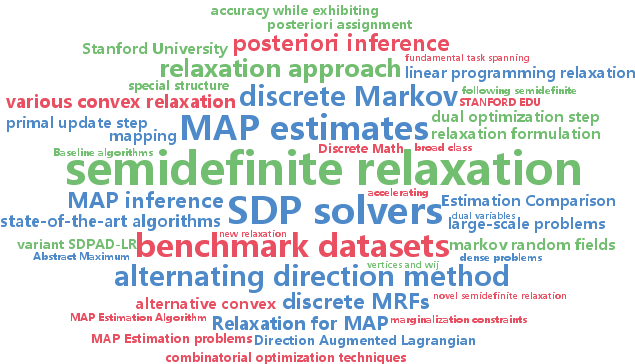alternating direction method
-
Zhiwei Qin and Weichang Li and Firdaus Janoos
Sparse Reinforcement Learning via Convex Optimization (pdf)
We propose two new algorithms for the sparse reinforcement learning problem based on different formulations. The first algorithm is an off-line method based on the alternating direction method of multipliers for solving a constrained formulation that explicitly controls the projected Bellman residual. The second algorithm is an online stochastic approximation algorithm that employs the regularized dual averaging technique, using the Lagrangian formulation. The convergence of both algorithms are established. We demonstrate the performance of these algorithms through two classical examples.
-
Dani Yogatama and Noah Smith
Making the Most of Bag of Words: Sentence Regularization with Alternating Direction Method of Multipliers (pdf)
In many high-dimensional learning problems, only some parts of an observation are important to the prediction task; for example, the cues to correctly categorizing a document may lie in a handful of its sentences. We introduce a learning algorithm that exploits this intuition by encoding it in a regularizer. Specifically, we apply the sparse overlapping group lasso with one group for every bundle of features occurring together in a training-data sentence, leading to thousands to millions of overlapping groups. We show how to efficiently solve the resulting optimization challenge using the alternating directions method of multipliers. We find that the resulting method significantly outperforms competitive baselines (standard ridge, lasso, and elastic net regularizers) on a suite of real-world text categorization problems.
-
Wenliang Zhong and James Kwok
Fast Stochastic Alternating Direction Method of Multipliers (pdf)
We propose a new stochastic alternating direction method of multipliers (ADMM) algorithm, which incrementally approximates the full gradient in the linearized ADMM formulation. Besides having a low per-iteration complexity as existing stochastic ADMM algorithms, it improves the convergence rate on convex problems from $\mO(1/\sqrt{T
-
Chang Xu and Dacheng Tao and Chao Xu and Yong Rui
Large-margin Weakly Supervised Dimensionality Reduction (pdf)
This paper studies dimensionality reduction in a weakly supervised setting, in which the preference relationship between examples is indicated by weak cues. A novel framework is proposed that integrates two aspects of the large margin principle (angle and distance), which simultaneously encourage angle consistency between preference pairs and maximize the distance between examples in preference pairs. Two specific algorithms are developed: an alternating direction method to learn a linear transformation matrix and a gradient boosting technique to optimize a non-linear transformation directly in the function space. Theoretical analysis demonstrates that the proposed large margin optimization criteria can strengthen and improve the robustness and generalization performance of preference learning algorithms on the obtained low-dimensional subspace. Experimental results on real-world datasets demonstrate the significance of studying dimensionality reduction in the weakly supervised setting and the effectiveness of the proposed framework.
-
Samaneh Azadi and Suvrit Sra
Towards an optimal stochastic alternating direction method of multipliers (pdf)
We study regularized stochastic convex optimization subject to linear equality constraints. This class of problems was recently also studied by Ouyang et al. (2013) and Suzuki (2013); both introduced similar stochastic alternating direction method of multipliers (SADMM) algorithms. However, the analysis of both papers led to suboptimal convergence rates. This paper presents two new SADMM methods: (i) the first attains the minimax optimal rate of O(1/k) for nonsmooth strongly-convex stochastic problems; while (ii) the second progresses towards an optimal rate by exhibiting an O(1/k^2) rate for the smooth part. We present several experiments with our new methods; the results indicate improved performance over competing ADMM methods.
-
Jie Wang and Qingyang Li and Sen Yang and Wei Fan and Peter Wonka and Jieping Ye
A Highly Scalable Parallel Algorithm for Isotropic Total Variation Models (pdf)
Total variation (TV) models are among the most popular and successful tools in signal processing. However, due to the complex nature of the TV term, it is challenging to efficiently compute a solution for large-scale problems. State-of-the-art algorithms that are based on the alternating direction method of multipliers (ADMM) often involve solving large-size linear systems. In this paper, we propose a highly scalable parallel algorithm for TV models that is based on a novel decomposition strategy of the problem domain. As a result, the TV models can be decoupled into a set of small and independent subproblems, which admit closed form solutions. This makes our approach particularly suitable for parallel implementation. Our algorithm is guaranteed to converge to its global minimum. With $N$ variables and n_p processes, the time complexity is O(N/(epsilon n_p)) to reach an epsilon-optimal solution. Extensive experiments demonstrate that our approach outperforms existing state-of-the-art algorithms, especially in dealing with high-resolution, mega-size images.
-
Taiji Suzuki
Stochastic Dual Coordinate Ascent with Alternating Direction Method of Multipliers (pdf)
We propose a new stochastic dual coordinate ascent technique that can be applied to a wide range of regularized learning problems. Our method is based on alternating direction method of multipliers (ADMM) to deal with complex regularization functions such as structured regularizations. Although the original ADMM is a batch method, the proposed method offers a stochastic update rule where each iteration requires only one or few sample observations. Moreover, our method can naturally afford mini-batch update and it gives speed up of convergence. We show that, under mild assumptions, our method converges exponentially. The numerical experiments show that our method actually performs efficiently.
-
Ruiliang Zhang and James Kwok
Asynchronous Distributed ADMM for Consensus Optimization (pdf)
Distributed optimization algorithms are highly attractive for solving big data problems. In particular, many machine learning problems can be formulated as the global consensus optimization problem, which can then be solved in a distributed manner by the alternating direction method of multipliers (ADMM) algorithm. However, this suffers from the straggler problem as its updates have to be synchronized. In this paper, we propose an asynchronous ADMM algorithm by using two conditions to control the asynchrony: partial barrier and bounded delay. The proposed algorithm has a simple structure and good convergence guarantees (its convergence rate can be reduced to that of its synchronous counterpart). Experiments on different distributed ADMM applications show that asynchrony reduces the time on network waiting, and achieves faster convergence than its synchronous counterpart in terms of the wall clock time.
-
Qixing Huang and Yuxin Chen and Leonidas Guibas
Scalable Semidefinite Relaxation for Maximum A Posterior Estimation (pdf)
Maximum a posteriori (MAP) inference over discrete Markov random fields is a central task spanning a wide spectrum of real-world applications but known to be NP-hard for general graphs. In this paper, we propose a novel semidefinite relaxation formulation (referred to as SDR) to estimate the MAP assignment. Algorithmically, we develop an accelerated variant of the alternating direction method of multipliers (referred to as SDPAD-LR) that can effectively exploit the special structure of SDR. Encouragingly, the proposed procedure allows solving SDR for large-scale problems, e.g. problems comprising hundreds of thousands of variables with multiple states on a grid graph. Compared with prior SDP solvers, SDPAD-LR is capable of attaining comparable accuracy while exhibiting remarkably improved scalability. This contradicts the commonly held belief that semidefinite relaxation can only been applied on small-scale problems. We have evaluated the performance of SDR on various benchmark datasets including OPENGM2 and PIC. Experimental results demonstrate that for a broad class of problems, SDPAD-LR outperforms state-of-the-art algorithms in producing better MAP assignments.
